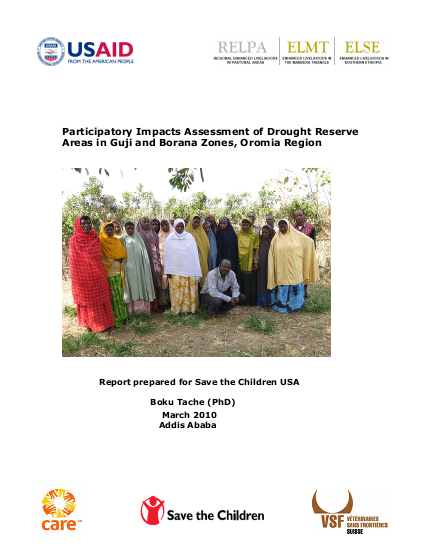
This report investigates the impacts of drought reserve areas supported by Save the Children USA in Guji and Borana Zones of Oromia Regional State. The report is based on participatory impact assessment exercise conducted over the period of 12-25 February 2010. It is organized into V main sections. Section I introduces the objectives of the assignment, major questions raised and methods employed in addressing them. The Section opens up by revisiting the ecological foundation of drought reserves in the variable environment where pastoralists practice extended livestock production, and winds up with presentation of limitations to the exercise and forwards suggestion for bridging the lacuna created by the limitations. Section II is about detailed case studies on history, status, management details and benefits generated from 12 purposively selected drought reserves. It presents a descriptive account of each site, mainly on the basis of interview and observation data. Section III briefly presents views of government partners on drought reserves. In Section IV, a summary of key findings is presented while Section V provides recommendations on way forward with drought reserves and rangeland development in southern Oromia. The recommendation comprises synthesis of the assessment for policy direction and site-specific suggestions to address problems affecting individual reserve site. The enclosures are found in different statuses and present diverse pictures: some are intact and fully functional, serving the community as fallback reserve during times of critical pasture shortage as was planned; some dysfunctional and management disrupted due to inter-ethnic conflicts and displacement; while others have digressed from the original objectives due to introduction of hay sale. Regarding impacts, there is a consensus among the informants concerning the role of drought reserves in protecting the pastoralist asset. If well managed and integrated with customary land use, drought reserves could be remarkable range management tool as they are based on indigenous ecological knowledge in availing fodder for critical times and integrating aspects of environmental conservation, resource use and pest control. Therefore, support to careful promotion of drought reserves must be accompanied by simultaneous support to revitalization of pastoralist land use systems through, among others, systematization and pattering of pastoralist villages in the manner that allows perennial pasture and ensures smooth inter-seasonal transition.
